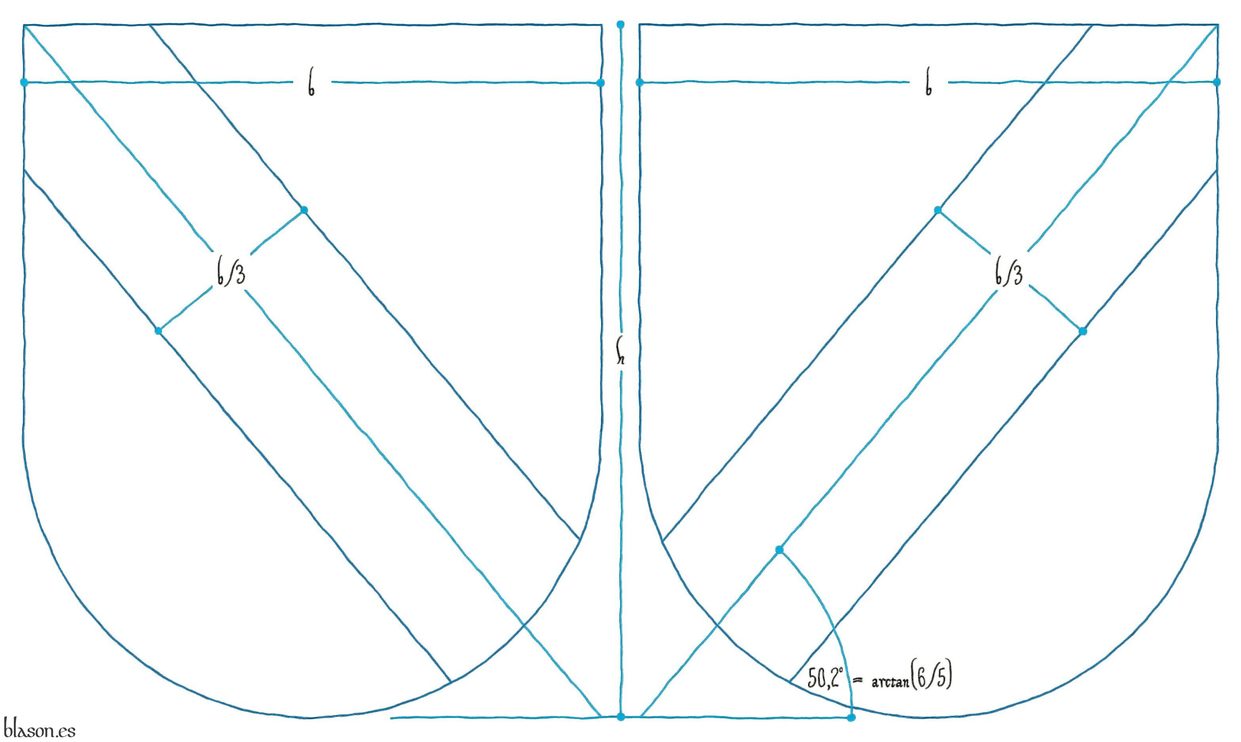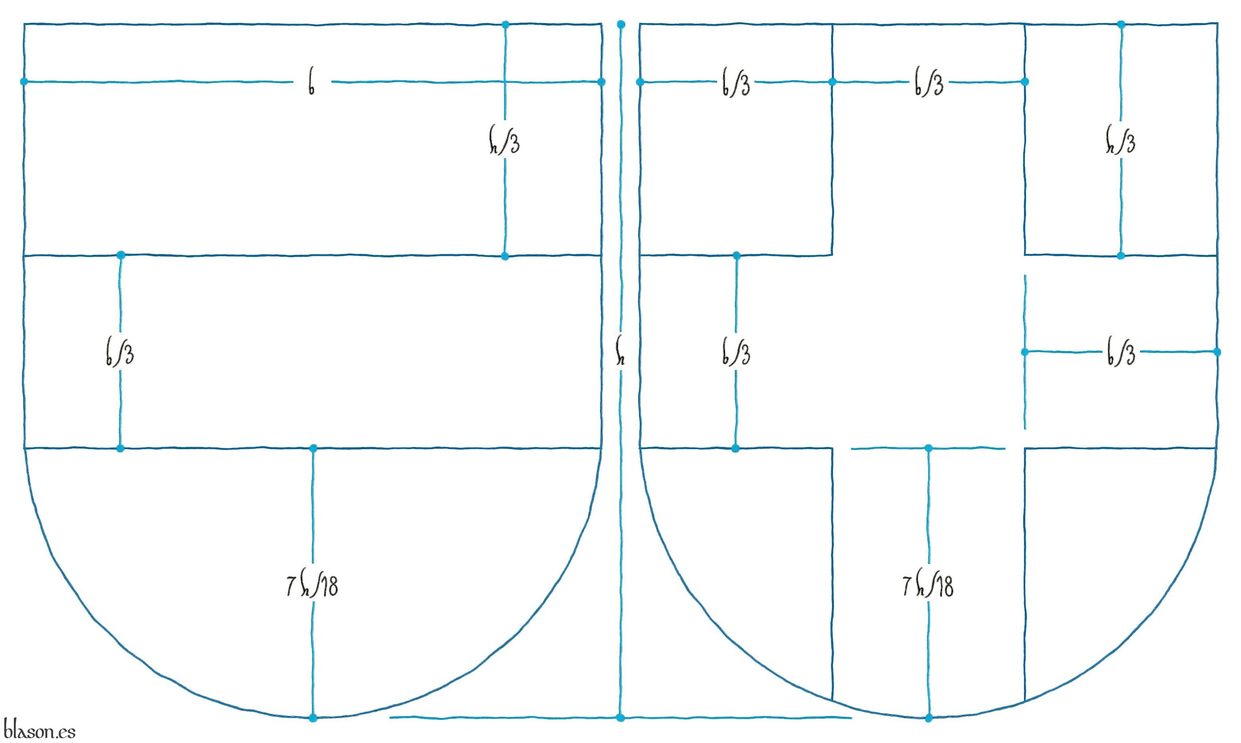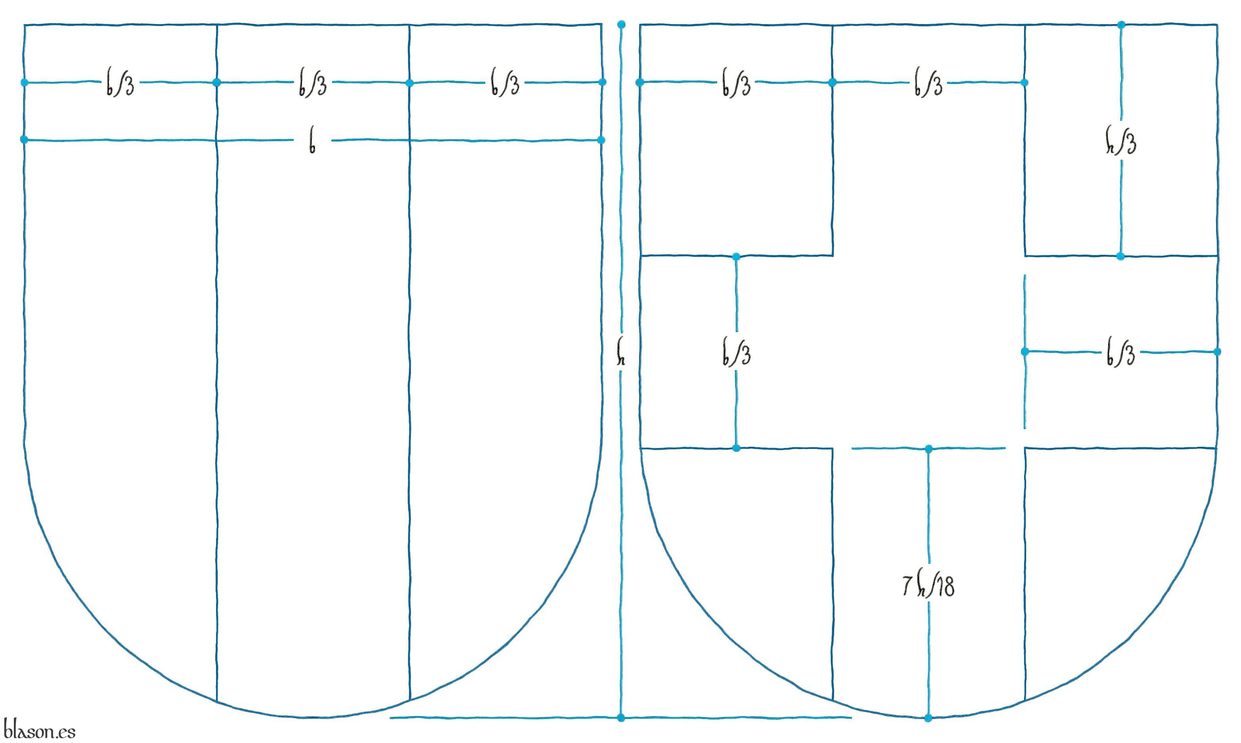
Scheme of a bend and a bend sinister
Proportions and angle of a bend and a bend sinister.
The proportion of a coat of arms is 5/6,
- with 5 being the base, the so-called adjacent side, b in the diagram, and
- with 6 being the height, the so-called opposite side, h in the diagram.
The tangent of the angle between the base of the shield and the diagonal of the bend is calculated as the opposite side divided by the adjacent side, that is, 6 divided by 5 which is 1.2 = 6/5.
If I wish to know the angle, I must apply the inverse function of the tangent, which is the arctangent. Therefore, the angle is arctangent(6/5) = arctangent(1.2) = 50.194o, which in radians is 0.876, and I usually round it to 50.2o.
The complementary angle to 50.2o is 39.8o (90o - 50.2o = 39.8o), which is the angle formed between the diagonal of the bend sinister and the dexter side of the shield.
Depending on the artist, on his style or, in other cases, on the need to organize the space within the shield, angles of 45o can also be used, corresponding to the diagonal angle of a square.
Blazon keywords: Without divisions, Bend and Bend sinister.
Style keywords: Semi-circular.
Classification: Schema and Coat of arms.
Bearer: Zúñiga y Guzmán, Álvaro de.


Savoy, Duchy of
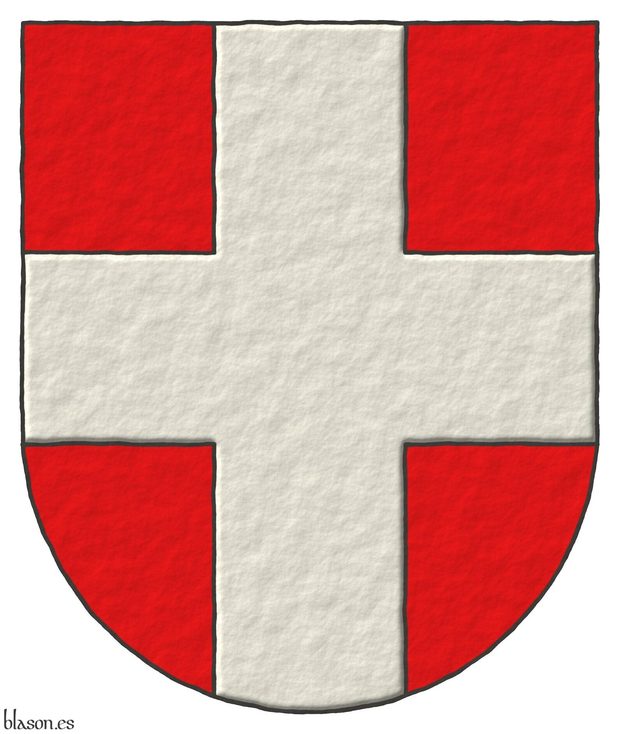
Gules, a cross Argent.
Escudo de gules, una cruz de plata.
Coat of arms of the House of Savoy and the Duchy of Savoy, which I have interpreted as follows: the shield has a semicircular (round) base; the field is illuminated in flat tincture Gules; the cross is illuminated in Argent; and the whole coat of arms is rendered with a raised-stroke effect.
This coat of arms is both familial and political, for it is also the coat of arms of the French departments of Savoy and Haute-Savoie, both belonging to the Rhône-Alpes region.
The cross in this shield is an honourable ordinary, for it is a full cross, the result of combining a fess and a pale. This full cross is wide and reaches the edges of the shield and is therefore large enough to bear charges. For this reason these ordinaries are called “honourable,” because they may be honoured with additional charges. In English heraldry they are known as «ordinaries», [The Heraldry Society; 2013; page 11].
This coat of arms is recorded in the armorial [Marshal, L.; 1295; shield number 32] together with the text «Le Counte de Sauveys, Gules a cross argent, Amadeus V, Comte de Savoie».
Blazon keywords: Without divisions, Gules, Argent and Cross.
Style keywords: Semi-circular, Illuminated and Freehand.
Classification: Interpreted, Personal, Coat of arms and House of Savoy.
Bearer: Savoy, Duchy of.


Haute-Savoie
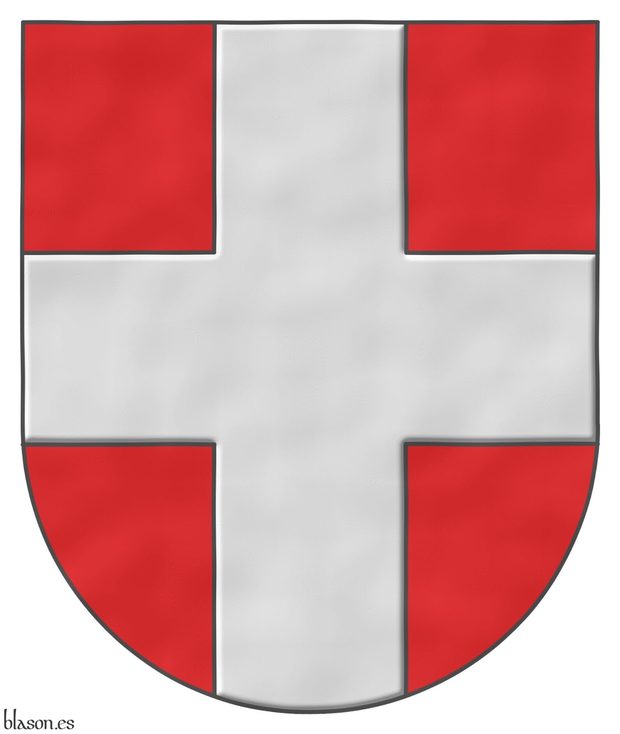
Gules, a cross Argent.
Escudo de gules, una cruz de plata.
Existing coat of arms interpreted by me of the following form: the shape of the shield is semi-circular; the tincture of the field is gules; the tincture of the cross is metal argente; and all the coat of arms has a watercolor finish.
In French its blazon is «de gueules à la croix d'argent».
Blazon keywords: Without divisions, Gules, Argent and Cross.
Style keywords: Semi-circular, Illuminated and Watercolor.
Classification: Interpreted, Civic, Coat of arms and House of Savoy.
Bearer: Savoy, Duchy of.


Scheme with a fess and a cross
Proportions of the cross and its similarity with the fess.
This schema shows two coats of arms, the first with the proportion scheme of a fess, the second with the proportion scheme of a cross, and allows us to observe the common proportions between a fess and a cross.
Blazon keywords: Without divisions, Fess and Cross.
Style keywords: Semi-circular.
Classification: Schema and Coat of arms.
Bearer: Savoy, Duchy of.


Scheme with a pale and a cross
Proportions of the cross and its similarity with the pale.
This schema shows two coats of arms, the first with the proportion scheme of a pale, the second with the proportion scheme of a cross, and allows us to observe the common proportions between a pale and a cross.
Blazon keywords: Without divisions, Pale and Cross.
Style keywords: Semi-circular.
Classification: Schema and Coat of arms.
Bearer: Saboya, Ducado de.


![Ver [Marshal, L.; 1295] en referencias bibliográficas. Libro abierto, hojas de plata, filo de oro, guardas de gules, tapas de sable.](../css/Libro.Bibliografia.png)
Marshal, L.; 1295
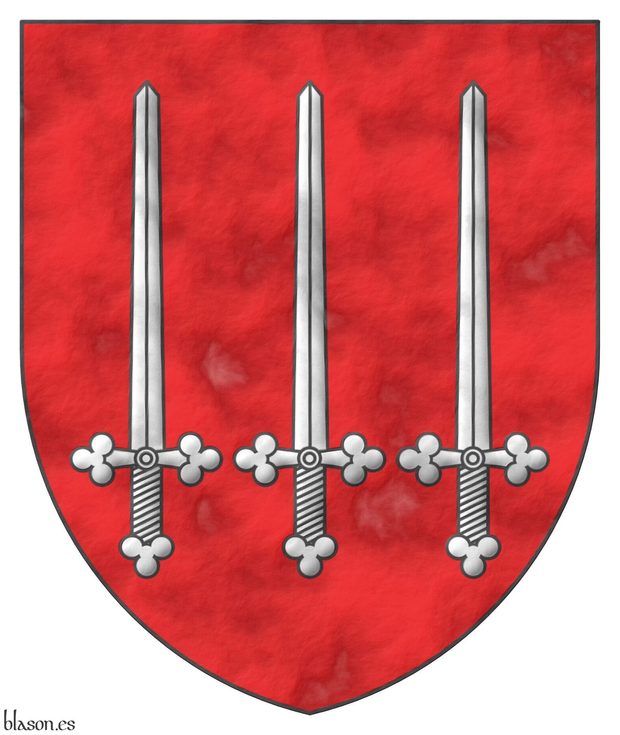
Lord Marshal, «The Lord Marshal's Roll», deposited in the Society of Antiquaries of London, code ms664, volume 1, ff 19-25, contains 565 painted shields, of which 42 are blank and 48 do not have the name of their associated holder, dated 1295.
This armorial contains the systematic error of representing, in many of its registered shields, the metal gold as metal silver, and some of its shields are not easy to decipher. Therefore, this armorial cannot be considered a completely reliable and definitive source of certain coats of arms.
[Brault, G. J.; 1997] is a good reference for the analysis of this armorial and in Brian Timms you can see a current interpretation of the coats of arms recorded in it, among them the shield of William de Colebrand that illustrates this bibliographic reference.
At the beginning of the second half of the 13th century, the use of coats of arms increased, this increase led to the appearance of the first armorials in which the name of their holders was recorded along with the blazon describing their coats of arms, possibly including the painted shields.
Bibliographical reference of century XIII.
The author is Marshal, Lord.
Bibliographic reference mentioned in the following articles:
External resource:


IESE
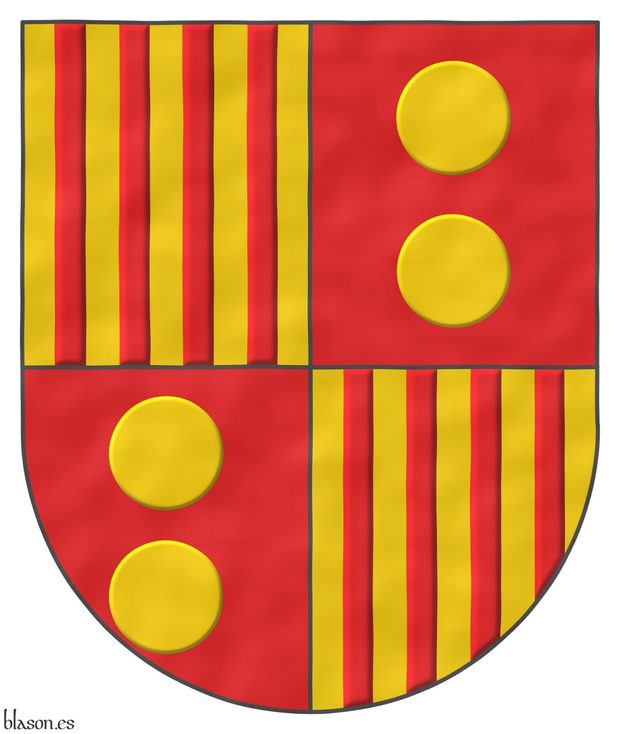
Quarterly: 1 and 4 Or, four pallets Gules; 2 and 3 Gules, two bezants in pale.
Escudo cuartelado: 1o y 4o de oro, cuatro palos de gules; 2o y 3o de gules, dos bezantes en palo de oro.
Coat of arms of the IESE Business School, which I have interpreted as follows: the shield has a semicircular (round) base; the field is illuminated in flat tinctures Or and Gules; the pales and the bezants are illuminated in Gules and Or; and the whole coat of arms has a watercolor finish.
I have the honour of holding a Master’s Degree in Business Administration from IESE of the University of Navarra. I always say that, as a whole, the IESE Executive MBA is the best education I have received throughout my life. I keep very good memories and friends from those two years of study.
Blazon keywords: Quarterly, Gules, Or, Pale, Bezant and plate and In pale.
Style keywords: Semi-circular, Illuminated and Watercolor.
Classification: Interpreted, Socioeconomic, Education and Coat of arms.
Bearer: IESE.


IESE, University of Navarra
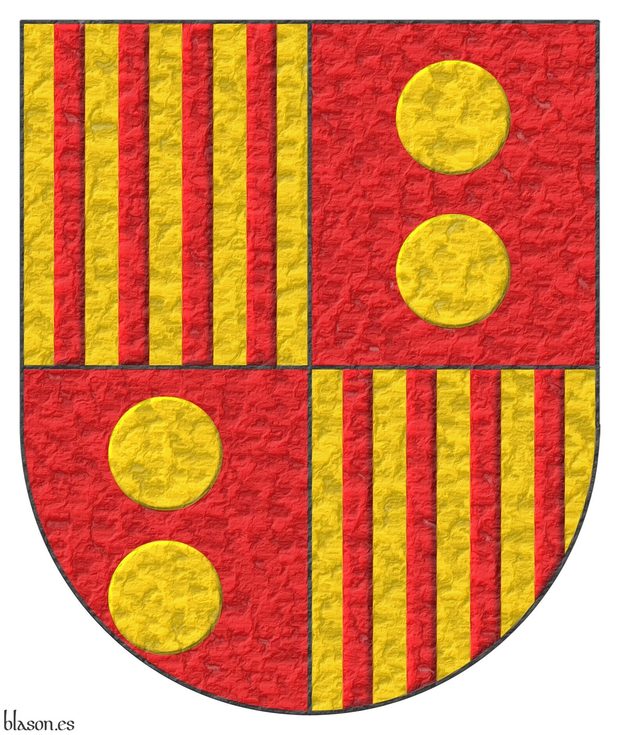
Quarterly: 1 and 4 Or, four pallets Gules; 2 and 3 Gules, two bezants in pale.
Escudo cuartelado: 1o y 4o de oro, cuatro palos de gules; 2o y 3o de gules, dos bezantes en palo de oro.
Coat of arms of IESE interpreted by me as follows: the shield has a semicircular (round) base; the field is illuminated in flat tinctures Or and Gules; the eight pales and the four bezants are illuminated in Gules and Or; and the whole coat of arms has a beaten metal finish.
IESE was founded in 1958 under the name Institute of Higher Business Studies, it is the business management school of the University of Navarra and is currently known as IESE Business School.
Blazon keywords: Quarterly, Gules, Or, Pale, Bezant and plate and In pale.
Style keywords: Semi-circular, Illuminated and Metal beaten.
Classification: Interpreted, Socioeconomic, Education and Coat of arms.
Bearer: IESE.

Continue with: University of Navarra.
-
Language
-
Categories of heraldry
-
Divisions of the field
- Without divisions
- Party per pale
- Party per fess
- Party per bend
- Party per bend sinister
- Tierce
- Tierce sinister
- Tierced per pale
- Tierced per fess
- Tierced per bend
- Tierced pallwise inverted
- Quarterly
- Quarterly per saltire
- Gyronny
- Party per fess, the chief per pale
- Party per pale, the sinister per fess
- Party per fess, the base per pale
- Party per pale, the dexter per fess
- Chapé
- Chaussé
- Embrassé
- Contre-embrassé
- Party per chevron
- Enté
- Enté en point
- Flanched
-
Metals
-
Colours
-
Furs
-
Other tinctures
-
Ordinaries and sub-ordinaries
-
Diminutives of the ordinaries
-
Other charges
-
Inanimate charges from Nature
Atom, Crescent, Diamond, Emerald, Estoile, Increscent, Lightning flash, Moon, Mount, Mullet, Mullet of four points, Orbital, Plough of Ursa Major, Rainbow, Ray of the sun, River, Sea, Snowflake, Sun, Sun in splendour, Sun of May, Trimount and Water.
-
Vegetal charges from Nature
Acorn, Apple, Apple tree, Ash, Bluebonnet, Camellia, Chrysanthemum, Cinquefoil, Cornflower, Dogwood flower, Double rose, Elm, Fleur de lis, Flower, Holm oak, Hop cone, Kapok tree, Laurel, Lily, Linden, Lotus flower, Madonna lily, Oak, Olive tree, Palm tree, Pomegranate, Poplar leaf, Rose, Shamrock, Sunflower, Thistle, Tree, Tulip, Vine and Wheat.
-
Animal charges from Nature
Badger, Bald eagle, Barbel, Barn owl, Bear, Beaver, Beetle, Bighorn sheep, Blackbird, Boar, Brach hound, Bull, Doe, Dog, Dolphin, Dove, Eagle, Elephant, Falcon, Fish, Flame, Fly, Fox, Frog, Goat, Goldfinch, Goose, Heron, Horse, Hummingbird, Jaguar, Lark, Leopard, Lion, Lion passant, Lion rampant guardant, Lioness, Lynx, Male figure, Martlet, Merino ram, Owl, Panther, Parrot, Peacock, Pelican, Pelican in her piety, Puffin, Quetzal, Raven, Roe deer, Rooster, Savage, Seagull, Serpent, She-wolf, Stag, Starling, Tyger, Vulture, Warren hound and Wolf.
-
Parts of natural charges
Arm, Beak, Branch, Caboshed, Chest, Claw, Covert, Dorsal fin, Eagle claw, Ermine spot, Escallop, Feather, Foot (palmiped), Foreleg, Forepaw, Hand, Head, Heart, Hoof, Leaf, Neck, Ostrich feather, Palm frond, Paw, Roe deers' attires, Shoulder, Sprig, Stags' attires, Stem, Swallow-tail, Tail, Tail addorsed, Tail fin, Talon, Tooth, Trunk, Trunk (elephant), Two hands clasped, Two wings in vol, Udder, Wheat spike, Wing and Wrist.
-
Artificial charges
Ace of spades, Anchor, Anvil, Arch, Arm vambraced, Armillary sphere, Arrow, Axe, Bell, Bell tower, Beret, Bonfire, Book, Bookmark, Bow, Bridge, Broken, Buckle, Cannon, Cannon dismounted, Cannon port, Carbuncle, Castle, Celtic Trinity knot, Chain, Chess rooks, Church, Clarion, Clay pot, Closed book, Club, Comb, Compass rose, Conductor's baton, Cord, Covered cup, Crozier, Crucible, Cuffed, Cup, Cyclamor, Dagger, Double vajra, Drum, Ecclesiastical cap, Fanon, Federschwert, Fleam, Four crescents joined millsailwise, Galician granary, Garb, Gauntlet, Geometric solid, Grenade, Halberd, Hammer, Harp, Host, Hourglass, Key, Key ward, Knight, Knot, Lantern, Letter, Line, Loincloth, Menorah, Millrind, Millstone, Millwheel, Monstrance, Mortar, Mullet of six points pierced, Nail, Non-classic artifact, Norman ship, Number, Oar, Oil lamp, Open book, Page, Pair of scales, Parchment, Pestle, Piano, Plough share, Polish winged hussar, Port, Portcullis, Potent, Quill, Ribbon, Rosette of acanthus leaves, Sabre, Sackbut, Sail, Scroll, Scythe, Sheaf of tobacco, Ship, Skirt, Spear, Spear's head, Stairway, Star of David, Step, Sword, Symbol, Tetrahedron, Torch, Tower, Trident, Trumpet, Turret, Two-handed sword, Wagon-wheel, Water-bouget, Wheel, Winnowing fan and With a turret.
-
Immaterial charges
Angel, Archangel, Basilisk, Dragon, Dragon's head, Garuda, Golden fleece, Griffin, Heart enflamed, Mermaid, Our Lady of Mercy, Ouroboros, Paschal lamb, Pegasus, Phoenix, Sacred Heart of Jesus, Saint George, Sea-griffin, Trinity, Triton, Unicorn, Winged hand and Wyvern.
-
External elements
-
Heraldic creations
-
References
-
Formats
-
Keywords on this page
Watercolor, Point upwards, Archangel, Armed, Azure, Point downwards, Bend, Bend sinister, Bezant and plate, Bibliography, Chain, Charged, House of Savoy, Cross, Quarterly, Outlined in sable, Dexter, Dragon, Education, Emblem, In the fess point, In fess, In pale, The eyes, Coat of arms, Emerald, Sword, Schema, Fess, The fangs, Male figure, Personal, Gules, IESE, Illuminated, Interpreted, Langued, Spear, Semi-circular, Metal beaten, Soft metal, Nimbed, Or, Oval, Pale, Argent, Without divisions, Savoy, Duchy of and Socioeconomic.
